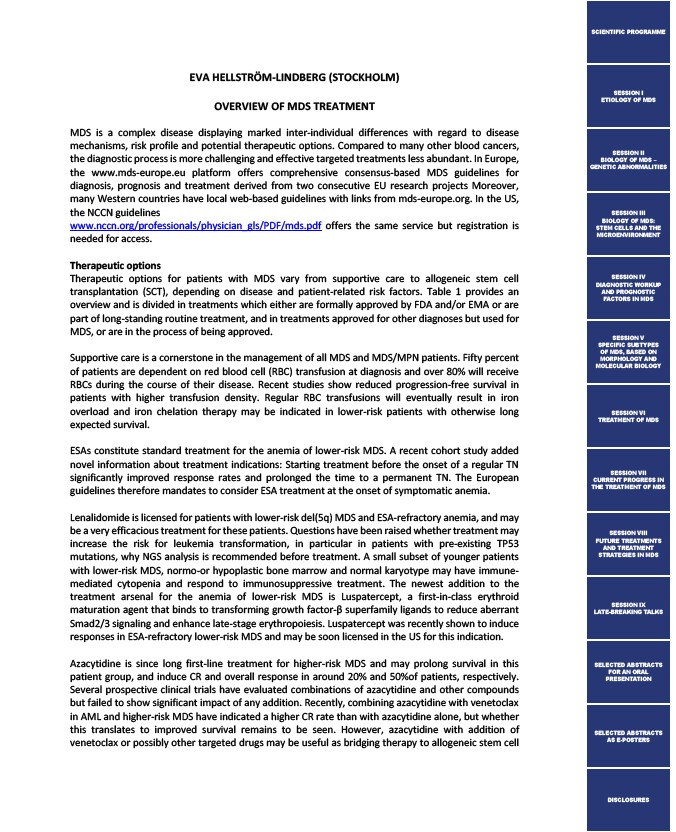
EVA HELLSTRÖM-LINDBERG (STOCKHOLM)
OVERVIEW OF MDS TREATMENT
MDS is a complex disease displaying marked inter-individual differences with regard to disease
mechanisms, risk profile and potential therapeutic options. Compared to many other blood cancers,
the diagnostic process is more challenging and effective targeted treatments less abundant. In Europe,
the www.mds-europe.eu platform offers comprehensive consensus-based MDS guidelines for
diagnosis, prognosis and treatment derived from two consecutive EU research projects Moreover,
many Western countries have local web-based guidelines with links from mds-europe.org. In the US,
the NCCN guidelines
www.nccn.org/professionals/physician_gls/PDF/mds.pdf offers the same service but registration is
needed for access.
Therapeutic options
Therapeutic options for patients with MDS vary from supportive care to allogeneic stem cell
transplantation (SCT), depending on disease and patient-related risk factors. Table 1 provides an
overview and is divided in treatments which either are formally approved by FDA and/or EMA or are
part of long-standing routine treatment, and in treatments approved for other diagnoses but used for
MDS, or are in the process of being approved.
Supportive care is a cornerstone in the management of all MDS and MDS/MPN patients. Fifty percent
of patients are dependent on red blood cell (RBC) transfusion at diagnosis and over 80% will receive
RBCs during the course of their disease. Recent studies show reduced progression-free survival in
patients with higher transfusion density. Regular RBC transfusions will eventually result in iron
overload and iron chelation therapy may be indicated in lower-risk patients with otherwise long
expected survival.
ESAs constitute standard treatment for the anemia of lower-risk MDS. A recent cohort study added
novel information about treatment indications: Starting treatment before the onset of a regular TN
significantly improved response rates and prolonged the time to a permanent TN. The European
guidelines therefore mandates to consider ESA treatment at the onset of symptomatic anemia.
Lenalidomide is licensed for patients with lower-risk del(5q) MDS and ESA-refractory anemia, and may
be a very efficacious treatment for these patients. Questions have been raised whether treatment may
increase the risk for leukemia transformation, in particular in patients with pre-existing TP53
mutations, why NGS analysis is recommended before treatment. A small subset of younger patients
with lower-risk MDS, normo-or hypoplastic bone marrow and normal karyotype may have immune-mediated
cytopenia and respond to immunosuppressive treatment. The newest addition to the
treatment arsenal for the anemia of lower-risk MDS is Luspatercept, a first-in-class erythroid
maturation agent that binds to transforming growth factor-β superfamily ligands to reduce aberrant
Smad2/3 signaling and enhance late-stage erythropoiesis. Luspatercept was recently shown to induce
responses in ESA-refractory lower-risk MDS and may be soon licensed in the US for this indication.
Azacytidine is since long first-line treatment for higher-risk MDS and may prolong survival in this
patient group, and induce CR and overall response in around 20% and 50%of patients, respectively.
Several prospective clinical trials have evaluated combinations of azacytidine and other compounds
but failed to show significant impact of any addition. Recently, combining azacytidine with venetoclax
in AML and higher-risk MDS have indicated a higher CR rate than with azacytidine alone, but whether
this translates to improved survival remains to be seen. However, azacytidine with addition of
venetoclax or possibly other targeted drugs may be useful as bridging therapy to allogeneic stem cell
SCIENTIFIC PROGRAMME
SESSION I
ETIOLOGY OF MDS
SESSION II
BIOLOGY OF MDS –
GENETIC ABNORMALITIES
SESSION III
BIOLOGY OF MDS:
STEM CELLS AND THE
MICROENVIRONMENT
SESSION IV
DIAGNOSTIC WORKUP
AND PROGNOSTIC
FACTORS IN MDS
SESSION V
SPECIFIC SUBTYPES
OF MDS, BASED ON
MORPHOLOGY AND
MOLECULAR BIOLOGY
SESSION VI
TREATMENT OF MDS
SESSION VII
CURRENT PROGRESS IN
THE TREATMENT OF MDS
SESSION VIII
FUTURE TREATMENTS
AND TREATMENT
STRATEGIES IN MDS
SESSION IX
LATE-BREAKING TALKS
SELECTED ABSTRACTS
FOR AN ORAL
PRESENTATION
SELECTED ABSTRACTS
AS E-POSTERS
DISCLOSURES